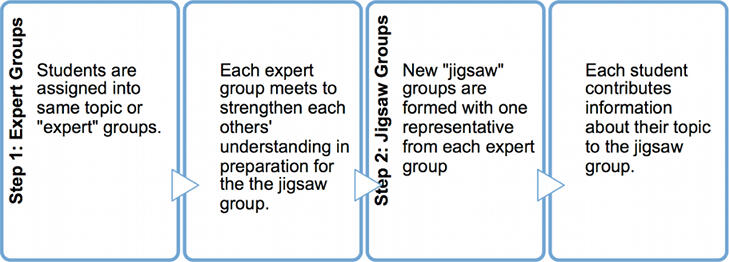
Credit: © Penn State is licensed under CC BY-NC-SA 4.0
The basic jigsaw method of collaborative learning is an activity that tasks each student in a small group with the responsibility for one topic (piece of the puzzle) and then requires that student to teach it to other learners within the group. To implement the jigsaw method, an instructor assigns a project topic to a team. The instructor could provide subtopics, or the team might decide on the subtopics. Each member of the team then researches their assigned subtopic and teaches their group members what they learned. It’s an effective approach to enhance collaboration and engagement in both online and face-to-face learning environments. It can be used in almost any discipline. Following is an example using satellite images from Pedagogy In Action.
Example using satellite images
Each student receives a different satellite image from a portion of a larger area. If carefully selected, each image could contain information on a portion of a regional story but not the entire story (which could be anything from land use to geomorphic history to structural evolution). After peer teaching, the team puts the entire image and data set together to work out the regional picture.
Example using data
Each student in a group receives and plots a small portion of a large data set. The student makes interpretations based on their portion of the data and then comes back to the group. Each student explains their plots and interpretations. After peer teaching, the group then combines the data sets, works out an interpretation of the complete data set, and addresses why individual team interpretations (based on incomplete data) might have been different.
Modified Assignment
The basic jigsaw method can be modified easily. Consider assigning small teams or pairs of students (instead of individuals) to work together to become experts and to then share their findings within a larger team. Alternatively, before sharing their findings within a larger team, expert pairs from one large team might consult with expert pairs from other teams that have investigated the same subtopic.

Credit: Amador, J.A., Mederer, H. (2013). Migrating Successful Student Engagement Strategies Online: Opportunities and Challenges Using Jigsaw Groups and Problem-Based Learning. Journal of Online Learning and Teaching, 9 (1). https://jolt.merlot.org/vol9no1/amador_0313.htm (CC BY-NC-SA 3.0 US)
Considerations
- Students benefit from receiving a group grade for the project. It serves as a way to keep everyone motivated.
- Online Implementation
- During online implementations, students are provided with more time to review or reflect on the information provided by their peers. This allows for more detailed and thoughtful interactions but also means the conversation is continually occurring.
- Smaller groups should be considered when implementing this strategy online to allow the instructor to maintain a strong focus on what each team is doing.